What Makes a Top Tier Bird Card in Wingspan?
Veterans of the core Wingspan experience understand the precedent set by Chihuahuan Raven, Common Raven, Franklin’s Gull, and Killdeer for ultra-powerful brown powers, but what really makes a “Top Tier” bird card in Wingspan?
Comparing the different power types in Wingspan and placing them on the same scale isn’t really an apples-to-apples comparison. The different power types/colors are designed to do different things at different times to varying degrees of impact. If we insist on using The Power 4 as the benchmark of what makes an ultra-powerful card (“When Activated” brown powers), we are going to blind ourselves to other incredibly powerful game effects produced by other power types/colors.
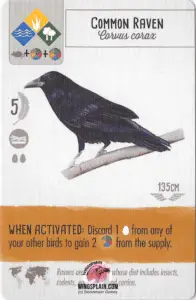
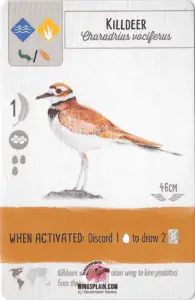
Top Tier “When Played” Powers in Wingspan
Bonelli’s Eagle (BE), and its “little brother” Eastern Imperial Eagle (EIE), are examples of S-Tier birds with a When Played power, in my opinion. Birds with When Played powers are designed to make one impact in one moment in time. This is going to result in some type of point swing or a burst of resources. When using their powers to full effect, these two birds represent the largest, most efficient, and most consistent point swings produced by this power type as of the Oceania Expansion. An apples-to-apples comparison would be to Atlantic Puffin.
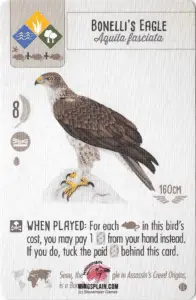
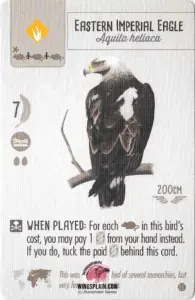
The Puffin is an eight-point bird that costs three fish to play (no getting around this) but its power is inconsistent with its point-scoring. You may get lucky and pull a maxed out seven or eight-point bonus card or you may whiff with a couple of zero-point duds.
I’m reminded of a game I played where the stars aligned, and I played the Puffin for a massive 21 net points, fulfilling the top end of multiple bonus cards thanks to its star nest and the fact that it pulled a maxed-out Wetland Scientist. Atlantic Puffin is a great card, I consider it to be one of the best birds in the game with a When Played power, but it isn’t game bending unless you get lucky. BE and EIE are consistently game-bending and blow Atlantic Puffin, and the birds like it, right out of the water. This sounds like something an S-Tier bird would do.
Something else that further empowers BE and EIE is their ability to be played off the back of Teal and Yellow-powered “Play Another Bird” powers (PABs). They flat out inflate the value of all PAB effects just by existing.
These types of plays are truly game-shattering in the context of what When Played Powers could traditionally do in the Core Set metagame. Playing BE and EIE and harvesting those points takes a lot less effort than milking the potential out of the brown powers of The Power 4, which require you to draw into better cards than your opponents and build infrastructure around them over the course of twenty-six turns.
The Wingspan Tournaments Discord has started to popularize the term “Raven Digging” (the concept of digging for Ravens as a high-impact win condition to be drawn in round one and played in round two; their house rules state that The Power Four can’t be played until round two).
I think this concept will eventually evolve or split into “Eagle Digging” as the tuck to play predators are universally more playable for a wider amount of game states as easy point bombs. If deemed to be “too powerful” by the tournament community, it will be interesting to see how they house rule them for online play.
During one such house rule discussion, I suggested that the cleanest/easiest solution would be to just treat these birds as predators with no power. If the alternative play method is used, it will be clearly noted as tucked cards on the bird. This makes for easy policing and greatly reduces their power, putting them in line with many other rodent-eating predator birds. Of course, this makes them as vanilla as can be which is no fun.
In summation, BE and EIE break the mold and set the precedent for what a “broken/overpowered/uber” When Played power looks like in Wingspan. As Wingspan Tournaments discord user Motherlove once aptly stated:
“The entire room always gets hyped when Bonelli appears in [the] tray, the good thing about Bonelli is that it’s the only bird you ALWAYS want, at any point in the game and no matter what engine you have.”
Top Tier Teal Powers in Wingspan
End of Round teal powers by their very nature are passive and slow-burning pseudo engines. I’m not yet sure if the following archetypes of birds are “S-Tier”, but they are worthy of consideration for that ranking (I have them both at Tier 0). They break the normal rules of the game by virtue of their teal powers and allow you to perform powerful/valuable actions up to four times in any given game.
Yellowhammer, Moltoni’s Warbler, and White Wagtail all have the same power and are close to being the same birds with some slight differences in the general qualities (which aren’t that impressive except that White Wagtail can hold up to five eggs). If these birds aren’t S-Tier now, that chance increases with each expansion release, purely by virtue of their interactions with birds that have alternative methods to play and birds that cost zero food.
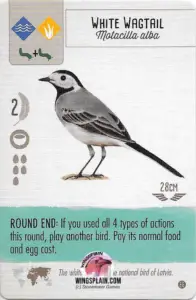
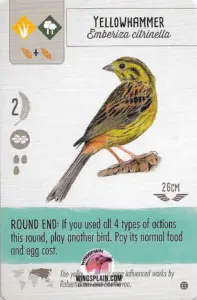
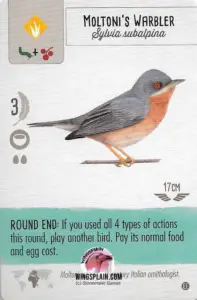
It has taken me a long time to warm up to these birds due to the level of micromanagement needed to use them properly; the smart manipulation of your actions to optimize their effect. There’s a lot more skill that comes into play when utilizing these powers which means there’s a lot more opportunity to misplay them too.
If you managed to play each action at least once in a round, the teal power of this archetype lets you play another bird, paying its normal costs. This power interacts incredibly well with play on top birds, tuck to play birds (such as he aforementioned Bonelli’s Eagle / Eastern Imperial Eagle), and zero food cost birds (vultures/California Condor).
“Play On Top” birds are regarded as some of the worst cards in the game but they can be free and easy points if you happen to have one in your hand at the end of the round, the conditions for your Yellowhammer have been met, and that Song Sparrow just isn’t pulling its weight anymore. All the better if you happen to have the right bonus cards, such as Rodentologist or Falconer.
Black Redstart and Lesser Whitethroat represent the second teal power archetype that are potentially S-Tier. They also require that you plan your entire game around them to optimize their powers but are fairly straight forward in their implementation. Playing more birds will use up your eggs and help you open the way for more from the Redstart/Whitethroat.
If done properly, you can generate a boat load of eggs off these birds and ignore the Lay Eggs Action entirely. This is a super premium ability in the Oceania Expansion metagame where the redesigned Grasslands produces fewer eggs. These birds are also pretty great at maxing out Oologist at the end of round four, potentially dropping one egg on five different birds.
They are worth zero points each and are very expensive given how poor their general qualities are, which tips us off to the fact that the designers saw this egg laying ability as game altering and powerful. The hallmark of S-Tier cards.
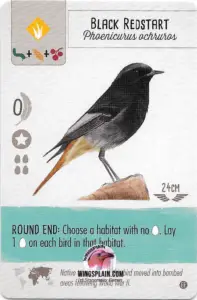
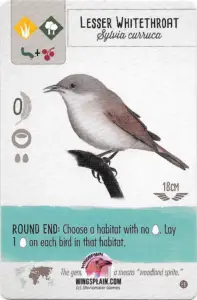
Top Tier Yellow Powers in Wingspan
Moving on to End of Game powers, we can see a trend developing. Being able to play extra birds outside the normal turn order is powerful, especially when you’re getting some type of resource discount on those birds making them easier to play (see Grey Headed Manikin).
As of the Oceania Expansion, I wouldn’t rate any Game End Yellow Powers as “S-Tier”. However, Magpie Lark (MPL) sits at the top of the yellow power pyramid and represents the best of what those birds are currently bringing to the table, in my opinion. I currently rate this as Tier 1 on my tier list.
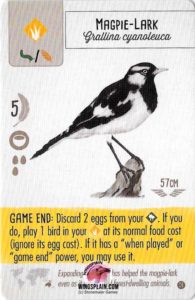
In classic S-Tier fashion, this bird is an interesting and powerful anomaly among other birds of its archetype (PAB birds). It is highly food efficient at five points for the cost of a single seed and its PAB power has a quirk: it will always cost you two eggs upfront that must come from a bird in your Forest (and then you subsequently ignore any egg costs associated with the column the extra bird is played into).
This is a balancing factor to this all-around great card, as this essentially sets the egg cost of playing the extra bird at two, regardless of what column the bird is going into. I’d probably also rate MPL as the best of the “one food cost for five-points” archetype of bird (although Clark’s Grebe may give it a run for its money due to its star nest and card cycling power).
Top Tier Pink Powers in Wingspan
“Once Between Turns” Pink powers have a lot more in common with “When Activated” Brown Powers than they do with other power types. Theoretically, this power type could be activated twenty-six times so you want to get them in place as soon as it makes sense to do so.
Most of the triggering events of these cards are specific and narrow, so there will be a time and a place for each one and they won’t necessarily be good every game. The exception to this would be the powers that trigger when your opponents lay eggs. This is a common occurrence during each game, although it could be greatly reduced in a two-player game (the worst case for all pink powers).
I don’t think we’ve seen an “S-Tier” pink power yet (I can think of a couple of people who might disagree with me on that) but there is one bird that can be very strong under the right conditions.
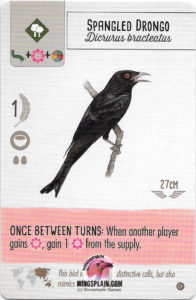
If there is an S-Tier pink power bird, Spangled Drongo (SP) is probably it. In a four to five player game using Oceania Expansion rules, SP is a hard counter to many nectar gaining birds such as Hummingbirds, Silvereye, Lewin’s Honeyeater, Eastern Rosella, Sulphur-Crested Cockatoo, Common Nightingale, and Bluethroat, which will all “give” a SP player two nectar to their one. That’s Raven level food.
This is probably the most direct counter play interaction in Wingspan. There may be a huge psychological aspect to playing the SP in multiplayer games and fighting over the most valuable food type, as your opponents may throttle their own actions and play hot potato with “who’s gonna trigger the Drongo?” SP also provides a bit of a silver lining in the face of an opposing Raven that’s taking two nectar per activation.
Spangled Drongo distorts some game states in such a way that it chokes opposing attempts at nectar production in a significant way. In my opinion, there is no other pink power that can have this type of game warping effect, and warping the game is an S-Tier quality. See what other player’s thought about this bird by checking out the results of our poll here.
More Top Tier Brown Powers in Wingspan
As previously stated, The Power Four (P4) have established what S-Tier birds with a “When Activated” power can look like. With these birds in the Grasslands, it takes the form of generating large quantities of eggs, cards, and food simultaneously. These resources must then be converted into points through additional actions.
The Wingspan European Expansion introduced an archetype of bird that took tucking to a whole new level, breaking the mold of what conventional tucking powers could do in the Core Set by tucking three to five cards at a time.
Common Chiffchaff (CCC) is one of those “mass tucking birds” and is another example of what an S-Tier bird with a When Activated power might look like. CCC creates boat loads of points by tucking cards across multiple birds. A single minded Wetlands engine is mandatory to even attempt to feed this ravenous card eater and its the reason why CCC’s counterpart, Common Chaffinch, isn’t nearly as effective at mass tucking (it can’t be played in the Wetlands).
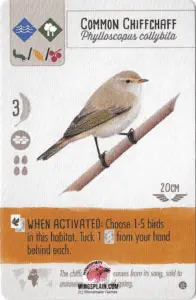
CCC can’t do it all on its own (which is a good thing for card balance). It wants to be surrounded by other birds who also generate points such as other tucking birds in order to create a mega-engine. Since a dedicated CCC Wetlands engine will be so starved for resources, a Tuck/Lay bird is a tremendous partner for Common Chiffchaff.
A bird that can draw two cards, such as a Ruddy Duck, is also an amazing boost and almost feels mandatory to support CCC properly, allowing it to “run on all cylinders”. Furthermore, since you probably won’t have any cards left in hand at the end of your turn, you have nothing to discard to the Ruddy Duck. CCC effectively allows you to avoid the drawback of cards that force you to discard.
Single minded pursuit of this engine means you’re probably going end up ignoring bonus cards, round goals, and playing any other birds that don’t do something passively from another habitat or directly help you add more birds to your Wetlands. Because of this, handing resources to a budding CCC engine is dangerous. It just needs six eggs, a few pieces of food, and some cheap tucking birds to start pushing its score to 130 points and beyond.
There’s going to be some micromanagement and math involved as you try to assess whether you should just tuck a high point value bird or attempt to play it (this ends up being another balancing factor for this card). Once your tuck/lay birds fill up it often becomes better to play those big birds instead of tucking them. Once again, Bonelli’s Eagle and its brethren become compelling, as their alternative play costs play right into the hands of a CCC engine that’s drawing a lot of cards and might not have the food to play them.
Going beyond this bird’s power and looking at its general qualities, it has a cheap and very flexible food cost which makes it easier to get onto the board. Its very food efficient coming in at three points for a single food. To top it all off, it even has a four egg nest (although you probably won’t make use of it). All of this bird’s qualities come together and reflect what an S-Tier brown power can look like in Wingspan.
Conclusion
That wraps up my analysis of qualities that make a top tier bird card in Wingspan. Shout out to my super talented wife at graphicsgurl.com for once again making an awesome thumbnail. Bonelli’s Eagle is snatching the crown from a Raven’s head in this article’s thumbnail.
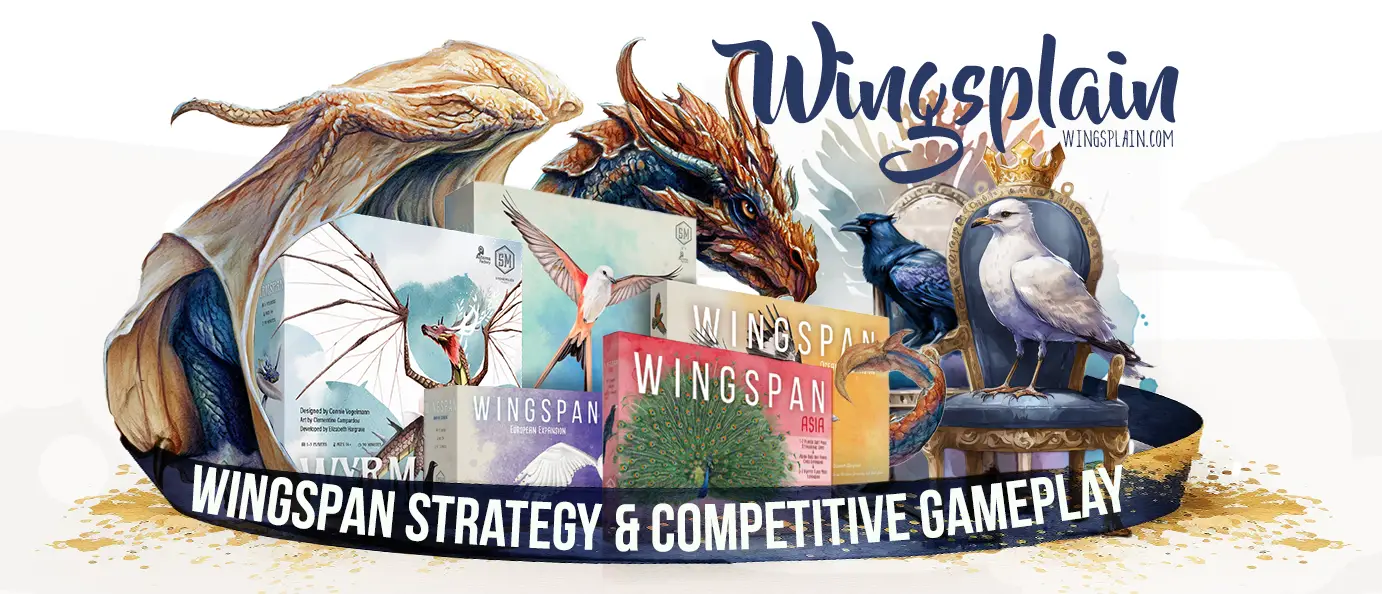
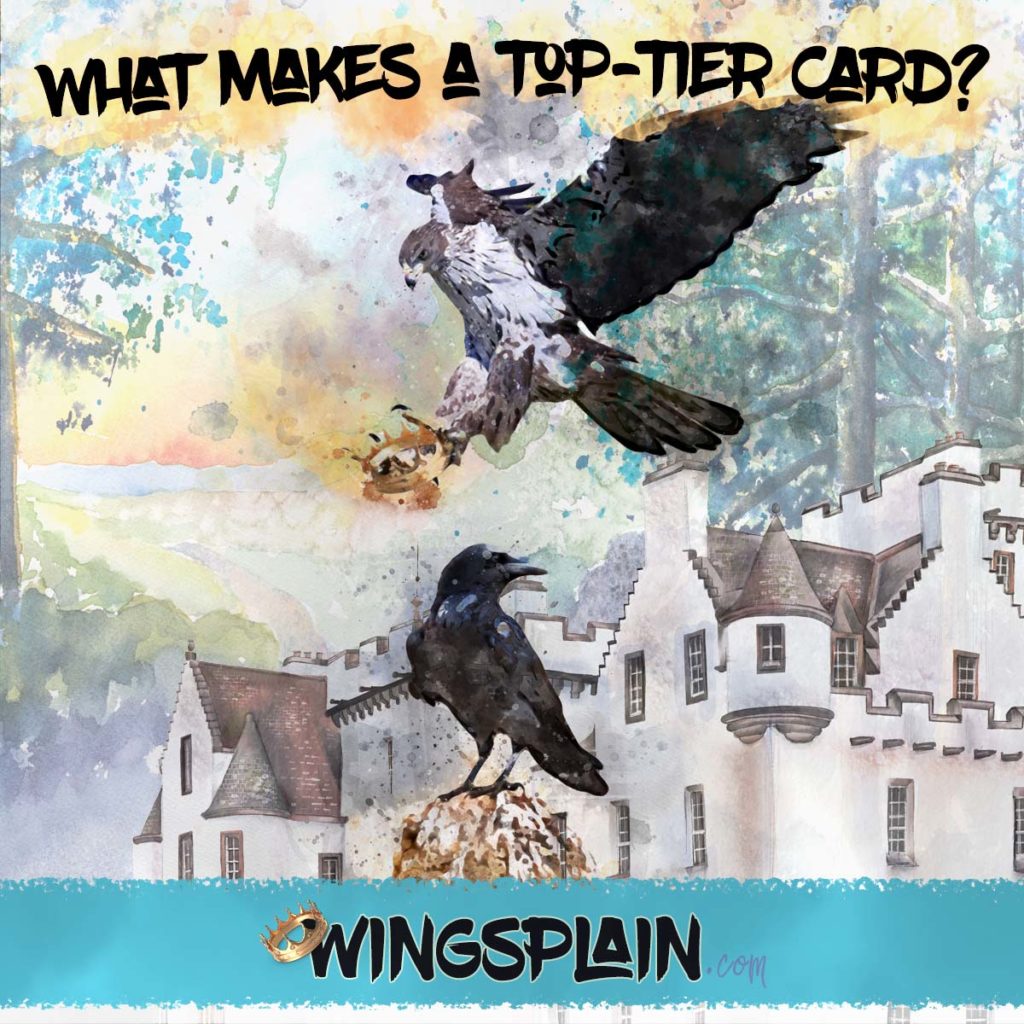

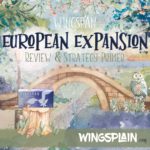
Great analysis!
You raise a very valid point, the power 4 do trick us into a pretty rigid way of thinking about OP birds. I always say that the game is a balance between gaining resources and converting resources into points. The power 4 are all resource gaining powers which cannot be directly compared to powers that convert resources into points such as Bonelli or CCC.
I wanted to develop a little bit on PABs, because in a way I think they synergise quite well with almost every other teal power.
– With egg laying teal powers: PABs give you the flexibility to choose between either playing a bird and clearing spaces, potentially meeting the condition for a whitethroat or clearing a dunnock, before activating it, while also increasing your row size (for whitethroat) or number of cavity nests (for goldeneye). Or to instead lay the eggs first and use those eggs to be able to play a bird with the PAB power. Which means resource management becomes easier.
– With card cycling abilities: Ruff and hooded crow can allow you to essentially “try again” if you didn’t manage to get a good bird to play, before you activate your PAB. This is especially useful in later rounds when you are more rigid in your actions, and cannot use another draw action if a powerful bird shows up in tray.
– Honey Buzzard: Honey buzzard is a weird one because its power is often useless in round 4 beyond tiebreakers. PABs are some of the only birds that actually take advantage of that in a significant way, by gambling for food to be able to play your bird.
– With eachother: PABs all have the same criteria for activation, so dropping a PAB on the round end means you can also use that PAB, acting as a white “play another bird” power. Except now you can play 2 birds on the round end everytime without the activation criteria becoming any harder.
I must admit for now it feels much harder to have a PAB pop off than a Raven for example, but they’re some of the most fun birds to play with.
> “If these birds aren’t S-Tier now, that chance increases with each expansion release, purely by virtue of their interactions with birds that have alternative methods to play and birds that cost zero food.”
This is noteworthy because OE has a peculiar new archetype, “delay” birds, which are Gould’s finch, Magpie Lark and grey headed Mannikin. Being all a single food cost, they often serve as a way to bide your time when you don’t have the resources to play the birds you want immediately. Essentially moving that responsibility to the end of the game. I think those birds should also, in theory, add to the PABs viability.
> “Since a dedicated CCC Wetlands engine will be so starved for resources, a Tuck/Lay bird is a tremendous partner for Common Chiffchaff.”
What is also noteable, on the EE mat, is that tuck and lay birds are really useful as transitional birds. Then end of the wetland row action allows you to discard an egg for an extra card, meaning that a tuck and lay can be used as a way to gain resource to fill your row, and then essentially converts into a tuck and draw as you continuously throw the egg for an extra card. I’ve been very impressed with the Chiffchaff so far, it’s surprisingly easy to make work, there’s not that much you can do against it, and it’s the best archetype for eagle digging.
Great article, an interesting talking point. And the thumbnail is amazing.
Great points, as usual, Motherlove. Thanks for commenting. I really haven’t thought about the combo potential between all of the teal powers (other than the obvious Honey Buzzard / discard food to tuck birds) so thanks for pointing that out. I’m currently working on post about the best combos in Wingspan and I’m now going to have to consider how teal powers interact with each other.
awsome article! I don’t have any of the expansions yet, and after reading this I definitly want to buy them!
Thanks for reading!
If you decide you want the expansions, you could support Wingsplain by using our affiliate links at the top of our main page. Thanks so much.
Thanks, Babe! 💕
(I just saw the “Conclusion” section)